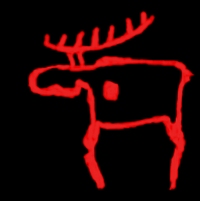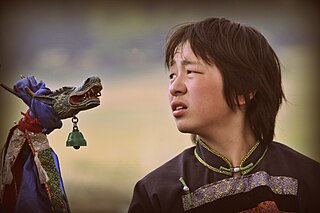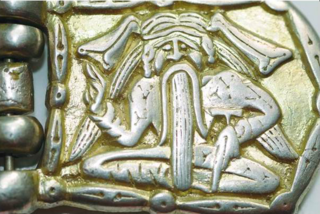Related Research Articles

Finno-Ugric or Finno-Ugrian (Fenno-Ugrian) is a traditional grouping of all languages in the Uralic language family except the Samoyedic languages. Its formerly commonly accepted status as a subfamily of Uralic is based on criteria formulated in the 19th century and is criticized by some contemporary linguists such as Tapani Salminen and Ante Aikio as inaccurate and misleading. The three most-spoken Uralic languages, Hungarian, Finnish, and Estonian, are all included in Finno-Ugric.

The Uralic languages form a language family of 38 languages spoken natively by approximately 25 million people, predominantly in Europe and Northern Asia. The Uralic languages with the most native speakers are Hungarian, Finnish and Estonian. Other significant languages with fewer speakers are Erzya, Moksha, Mari, Udmurt, Northern Sámi, Komi, Karelian and the Samoyedic languages, all of which are spoken in northern regions of Scandinavia and parts of the Russian Federation.

Ilmarinen, a blacksmith and inventor in the Kalevala, is a god and archetypal artificer from Finnish mythology. He is immortal and capable of creating practically anything, but is portrayed as being unlucky in love. He is described as working the known metals of the time, including brass, copper, iron, gold, and silver. The great works of Ilmarinen include the crafting of the dome of the sky and the forging of the Sampo. His usual epithet in the Kalevala is seppä or seppo ("smith"), which is the source of the given name Seppo.

Finnic paganism is the indigenous pagan religion in Finland, Karelia, Ingria and Estonia prior to Christianisation. It was a polytheistic religion, worshipping a number of different deities. The principal god was the god of thunder and the sky, Ukko; other important gods included Jumo (Jumala), Ahti, and Tapio. Jumala was a sky god; today, the word "Jumala" refers to all gods in general. Ahti was a god of the sea, waters and fish. Tapio was the god of forests and hunting.

The Permic or Permian languages are a branch of the Uralic language family. They are spoken in several regions to the west of the Ural Mountains within the Russian Federation. The total number of speakers is around 950,000, of which around 550,000 speak the most widely spoken language, Udmurt. Like other Uralic languages, the Permic languages are primarily agglutinative and have a rich system of grammatical cases. Unlike many others, they do not have vowel harmony.
Proto-Uralic is the unattested reconstructed language ancestral to the modern Uralic language family. The hypothetical language is thought to have been originally spoken in a small area in about 7000–2000 BCE, and expanded to give differentiated Proto-Languages. Some newer research has pushed the "Proto-Uralic homeland" east of the Ural Mountains into Western Siberia.

The Finno-Permic (Fenno-Permic) or Finno-Permian (Fenno-Permian) languages, or sometimes just Finnic (Fennic) languages, are a proposed subdivision of the Uralic languages which comprise the Balto-Finnic languages, Sámi languages, Mordvinic languages, Mari language, Permic languages and likely a number of extinct languages. In the traditional taxonomy of the Uralic languages, Finno-Permic is estimated to have split from Finno-Ugric around 3000–2500 BC, and branched into Permic languages and Finno-Volgaic languages around 2000 BC. Nowadays the validity of the group as a taxonomical entity is being questioned, and the interrelationships of its five branches are debated with little consensus.

The Ob-Ugric languages are a commonly proposed branch of the Uralic languages, grouping together the Khanty (Ostyak) and Mansi (Vogul) languages. Both languages are split in numerous and highly divergent dialects. They, along with Hungarian, are often thought to comprise the Ugric branch of the Uralic languages, though the acceptance of Ugric is less frequent than acceptance of Ob-Ugric.

A large minority of people in North Asia, particularly in Siberia, follow the religio-cultural practices of shamanism. Some researchers regard Siberia as the heartland of shamanism.

Hungarian mythology includes the myths, legends, folk tales, fairy tales and gods of the Hungarians, also known as the Magyarok.
Soul dualism, also called dualistic pluralism or multiple souls, is a range of beliefs that a person has two or more kinds of souls. In many cases, one of the souls is associated with body functions and the other one can leave the body. Sometimes the plethora of soul types can be even more complex. Sometimes, a shaman's "free soul" may be held to be able to undertake a spirit journey.

Hungarian shamanism is discovered through comparative methods in ethnology, designed to analyse and search ethnographic data of Hungarian folktales, songs, language, comparative cultures, and historical sources.
Finnic mythologies are the mythologies of the various Finnic peoples:
Komi mythology is the traditional mythology of the Komi peoples of northern Russia.

Tietäjä is a magically powerful figure in traditional Finno-Karelian culture, whose supernatural powers arise from his great knowledge.

Synty is an important concept in Finnish mythology. Syntysanat ('origin-words') or syntyloitsut ('origin-charms') provide an explanatory, mythical account of the origin of a phenomenon, material, or species, and were an important part of traditional Finno-Karelian culture, particularly in healing rituals. Although much in the Finnish traditional charms is paralleled elsewhere, 'the role of aetiological and cosmogonic myths' in Finnic tradition 'appears exceptional in Eurasia'. The major study remains that by Kaarle Krohn, published in 1917.
Arja Anna-Leena Siikala was a professor emeritus at the University of Helsinki, specialising in folk-belief, mythology, and shamanism, along with oral storytelling and traditionality.

Pre-Finno-Ugric substrate refers to substratum loanwords from unidentified non-Indo-European and non-Uralic languages that are found in various Finno-Ugric languages, most notably Sami. The presence of Pre-Finno-Ugric substrate in Sami languages was demonstrated by Ante Aikio. Janne Saarikivi points out that similar substrate words are present in Finnic languages as well, but in much smaller numbers.

The Finnic or Fennic peoples, sometimes simply called Finns, are the nations who speak languages traditionally classified in the Finnic language family, and which are thought to have originated in the region of the Volga River. The largest Finnic peoples by population are the Finns, the Estonians, the Mordvins (800,000), the Mari (570,000), the Udmurts (550,000), the Komis (330,000) and the Sami (100,000).
References
Citations
- 1 2 Aikio 2021, pp. 47–48.
- ↑ Honko 2017.
- ↑ Suomen Kansan Vanhat Runot VII Part 1: 11.
- ↑ Frog 2012.
Bibliography
- Aikio, Ante (2021). "Proto-Uralic". The Oxford Guide to the Uralic Languages. Oxford University Press.
- Frog (2012). Evolution, Revolution and Ethnocultural Substrata: From Finno-Ugric Sky-God to the North Finnic God-Smith Ilmarinen. International Symposium on Finno-Ugric Languages in Groningen.
- Frog; Siikala, Anna-Leena; Stepanova, Eila (2012). Mythic Discourses: Studies in Uralic Traditions. Finnish Literature Society. ISBN 978-952-222-376-0.
- Konakov; Kulemzin; Gemuev; Tuchkova, eds. (2003–2009). "Komi Mythology, Khanty Mythology, Mansi Mythology, Selkup Mythology". Encyclopaedia of Uralic Mythologies. Akadémiai Kiadó.
- Pentikäinen, Juha (1989). Uralic Mythology and Folklore. Ethnographic Inst. of the HAS. ISBN 978-963-7762-64-2.
- Suomen Kansan Vanhat Runot VII Part 1: 11. Finnish Literature Society SKS. 1929–1933.
- Honko, Lauri, ed. (2017). "Finno-Ugric Religion". Encyclopedia Britannica. Encyclopedia Britannica, Inc.